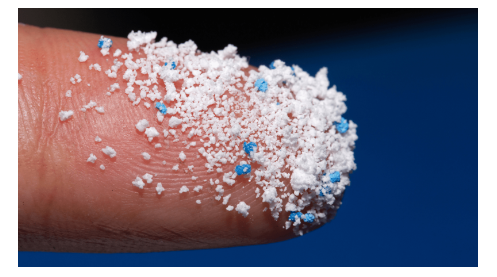By: Geraldus Sigap
In recent years, microplastics have emerged as a significant environmental and public health concern. These tiny plastic particles, often less than 5 millimeters in size, are pervasive in our oceans, air, and even our food supply. While much attention has been focused on the ecological impact of microplastics, a growing body of research suggests that these particles may also pose serious risks to human health, particularly in relation to heart disease.
Microplastics are small plastic fragments that result from the breakdown of larger plastic items or are manufactured as microbeads for use in products like cosmetics and toothpaste. Due to their minuscule size, they can easily infiltrate various ecosystems and enter the human body through ingestion or inhalation. Once inside the body, microplastics can travel through the bloodstream and lodge in different organs, potentially causing a range of health issues. One alarming example is the practice by some street vendors of frying plastic before frying food, particularly to achieve a certain crispness or texture in the food. When plastic is heated, harmful chemicals are released, which can contaminate the food being cooked. When consumed, these microplastics and associated chemicals can accumulate in our body, posing significant health risks.

Figure 1. Microplastic pollution
Emerging research has begun to explore the potential link between microplastics and cardiovascular health. A study published in the journal Environmental Science & Technology found that microplastics can cause oxidative stress, inflammation, and endothelial dysfunction in blood vessels, all of which are critical factors in the development of heart disease. The presence of microplastics in the bloodstream can also exacerbate existing cardiovascular conditions by increasing the risk of plaque formation in arteries, potentially leading to atherosclerosis. Furthermore, research has shown that individuals with higher levels of microplastics in their bodies are more likely to experience serious health problems such as heart attacks and strokes [3]. These findings suggest that microplastics may not only contribute to the onset of cardiovascular diseases but also worsen the outcomes for those already suffering from such conditions.
The exact mechanisms by which microplastics affect cardiovascular health are still being studied, but several hypotheses have been proposed. One possibility is that the physical presence of microplastics in the bloodstream may directly damage blood vessels. Additionally, the chemical additives in plastics, such as bisphenol A (BPA) and phthalates, are known endocrine disruptors that can interfere with normal hormonal functions, potentially leading to adverse cardiovascular effects.
Another significant concern is the inflammatory response triggered by microplastics. Chronic inflammation is a well-known risk factor for heart disease, and the presence of foreign particles like microplastics in the body can perpetuate a state of persistent inflammation. This ongoing inflammatory response can weaken the cardiovascular system over time, making it more susceptible to diseases.
The potential link between microplastics and heart disease underscores the urgent need for further research and public health initiatives to address this emerging threat. Reducing plastic pollution and limiting human exposure to microplastics are critical steps in mitigating the associated health risks. Policy measures aimed at regulating plastic use and improving waste management practices can play a vital role in reducing the prevalence of microplastics in the environment.
Given the potential health risks posed by microplastics, it is essential for individuals to take proactive measures to protect their cardiovascular health. This includes minimizing the use of plastic products, opting for alternatives such as glass or stainless steel, and supporting policies that aim to reduce plastic pollution. Ensuring that food is prepared with good hygiene practices, such as using clean cooking utensils, avoiding cross-contamination, and sourcing ingredients from reliable sources, can significantly reduce the risk of ingesting microplastics. Being aware of where and how our food is prepared empowers us to make safer, healthier choices. Additionally, regular health check-ups can help monitor and manage any potential health issues related to microplastic exposure.
At Abdi Waluyo Hospital, we understand the importance of maintaining heart health in the face of emerging environmental threats like microplastics. Our comprehensive cardiovascular medical check-up services are designed to provide you with a thorough assessment of your heart health. Our state-of-the-art facilities and experienced medical professionals ensure that you receive the highest quality care.
Resources
- De Boever S, Devisscher L, Vinken M. Unraveling the micro- and nanoplastic predicament: A human-centric insight. Sci Total Environ 2024;916:170262.
- New study links microplastics to serious health harms in humans | Environmental Working Group [Homepage on the Internet]. 2024 [cited 2024 Aug 8];Available from: https://www.ewg.org/news-insights/news/2024/03/new-study-links-microplastics-serious-health-harms-humans
